Every generation has been influenced by the unique toys and games of their childhood, but one piece has remained timeless for all. Dolls have been adored by their owners since ancient Rome, although their materials have changed over time – their enrichment has remained the same. As we grow older, these childhood companions may remain in our home – either well-worn or pristinely preserved – securely kept as a sentimental artefact or a valuable antique.
 Above: three dolls from different eras including 16th century Sweden, 18th century France and 19th century Britain
Above: three dolls from different eras including 16th century Sweden, 18th century France and 19th century Britain
This article will explore the history of dolls, as well as their styles, value and professional doll restoration by our conservators. The preservation of dolls may be complicated by the mixture of materials you may come across, from ceramics and paper to wood and wax. Our team of restorers have diverse areas of expertise, working together to preserve childhood memories alongside historically important designs.
 Above: a sketch by Eugène François de Block (1860), American cigarette card (1886), illustration by Tinbergen (1925-35) and a drawing by Lucien Pissarro (1873-1944)
Above: a sketch by Eugène François de Block (1860), American cigarette card (1886), illustration by Tinbergen (1925-35) and a drawing by Lucien Pissarro (1873-1944)
Doll history
A common belief behind the creation of dolls, especially those that mimic babies and young children, is that they were tools to prepare a girl for motherhood. In most civilisations, as far back as ancient history, this would have been accepted as the one and only route for their lives to take.
 Above: detail from a graphite, watercolour and pastel drawing by John Downman, 1780
Above: detail from a graphite, watercolour and pastel drawing by John Downman, 1780
However, these beloved toys would have also been a constant companion to their owner offering comfort as well as helping them to expand their imagination. Dolls that represent older, fashionable ladies, may have helped a girl to form a sense of self in a society that often had no clear gap between infancy and adulthood.
 Above: an engraving entitled L’Inclination de l’age after Chardin (1743), oil portrait of The Raymond Children by Robert Peckham (1838) and an etching entitled The Charming Doll after Bouchardon (1742)
Above: an engraving entitled L’Inclination de l’age after Chardin (1743), oil portrait of The Raymond Children by Robert Peckham (1838) and an etching entitled The Charming Doll after Bouchardon (1742)
Some of the oldest dolls in the world were discovered in Egyptian tombs, dating them as far back as the 21st century BC. Ancient Greece and Rome also have archaeological evidence of figurative toys, recorded in Greek literature as being ‘toys that were primarily made for young girls’.
 Above: terracotta dolls from ancient Greece, paddle dolls from ancient Egypt, a glass doll from ancient Iran and a bone doll from ancient Rome
Above: terracotta dolls from ancient Greece, paddle dolls from ancient Egypt, a glass doll from ancient Iran and a bone doll from ancient Rome
Little is known about dolls of the European mediaeval period. However, the renaissance saw a sharp incline in their manufacturing. Fashion dolls were designed in the 16th century specifically for ladies of the court and royalty – a helpful method of displaying new wardrobe choices in miniature form.
 Above: figurines from a Dutch dolls house, 1676
Above: figurines from a Dutch dolls house, 1676
Throughout the 17th and 18th centuries, dolls were being crafted from a variety of materials including wood, wax and papier-mache. They began to make more of an appearance in portraiture, as a symbol of childhood whims and impending motherhood.
 Above: three dolls from the 18th century
Above: three dolls from the 18th century
The 19th century saw the development of porcelain dolls as we know them today. The creation of bisque porcelain (ceramic with a matt surface) allowed for a smooth base for realistically applied facial features, as well as arms and legs. Today, French Bisque dolls are some of the most desirable in the antique market.
 Above: a miniature of a girl and doll (1854), a doll with porcelain head and leather limbs (1874) and a Daguerreotype portrait of a girl and her doll (1850s)
Above: a miniature of a girl and doll (1854), a doll with porcelain head and leather limbs (1874) and a Daguerreotype portrait of a girl and her doll (1850s)
By the mid 19th century, the concept of childhood was much more established than it had been in the past – growing numbers of children attended school and had time away from traditional labour to enjoy toys. In the early 20th century, plastic dolls were commonplace for children of all economic classes and popular products began to take hold of the market – most notably the Shirley Temple dolls of the 1930s. The history of dolls closely follows the evolution of childhood as a societal concept. You can find out more in our history of childhood portraiture here.
 Above: details from an portrait of a boy by Louis Léopold Boilly (1805), portrait of a girl by François-Hubert Drouais (18th century) and a hand-coloured photographic print of two sisters (1915)
Above: details from an portrait of a boy by Louis Léopold Boilly (1805), portrait of a girl by François-Hubert Drouais (18th century) and a hand-coloured photographic print of two sisters (1915)
Antique doll styles
Dolls are often described by collectors by their head type, this includes a shoulder head (fused to the shoulders), an open head (head with a hole in the crown), a domed head (a fully formed head under the hair) and a swivel head (with the ability to move).
 Above: drawings of different antique doll designs, 1930s
Above: drawings of different antique doll designs, 1930s
Dolls have been made from a variety of materials throughout history. In ancient Greece and Rome, figures were crafted from terracotta and sometimes bone. European dolls from the 16th to 18th century were made from wooden elements, sometimes coated with a gesso layer or wax to provide a base for decoration. Interior structure may have also been made from papier-mache or covered in leather.
It was not until the 19th century that porcelain dolls were popular and mass produced, thanks in part to the industrial revolution that allowed for the expansion of toy manufacturing. Later dolls, from the 20th century or beyond, may feature plastics or other manmade materials for safety and affordability.
 Above: drawings of different antique doll designs, 1930s
Above: drawings of different antique doll designs, 1930s
In Japanese history, there are many examples of ancient dolls such as Dogu figures dating to 8000–200 BC. However, they were not designed for the recreation of children until the 11th century. By this point they were also used for cultural and religious purposes and continue to be used at the Hinamatsuri festival. Hinamatsuri dolls may be as intricate as ceramics dressed in textiles or as simple as folded paper, they usually represent a traditional court wedding of the Heian period.
Kokeshi dolls have been created in Japan for more than 150 years. They are unique in their limbless appearance, often crafted from wood as a cylindrical body and rounded head. Their subtle aesthetic fitted in nicely with western mid-century interiors, making them attractive tourist souvenirs following the rejuvenation of trade with Japan during the post war period.
 Above: a selection of Japanese dolls, early 20th century
Above: a selection of Japanese dolls, early 20th century
Antique doll makers and value
Antique dolls can fetch high prices at auction, the leader in the industry is Theriault’s who have dedicated doll and toy auctions onlines and across the United States. In February 2022, an 18th century doll gifted by Queen Charlotte sold for £148,000 in Maryland. They also held the auction of Shirley Temple’s estate in 2015 featuring hundreds of dolls from her childhood collection. In the UK, a bisque doll by Kämmer & Reinhardt sold for £242,500 and an 18th century wooden doll achieved £28,750, both at Bonhams.
The most sought after names in the antique doll world include:
- Jumeau
- Steiff
- Kathe Kruse
- Montinari
- Pierotti
- John Edwards
- Lenci
- Bru
- Gaultier
- Steiner
- Kämmer and Reinhardt
- Armand Marseille
- Kestner and Co
- Gerbruder Heubach
- Simon and Halbig
 Above: drawings of different antique doll designs, 1930s
Above: drawings of different antique doll designs, 1930s
What can our conservators restore?
Whilst we do not run a traditional doll hospital, our conservators can apply their museum-level expertise to a wide range of materials. This allows a doll to be restored with historic accuracy and artistic integrity.
Our team can restore the following issues after an accidental breakage, water / fire damage or age-related deterioration:
- Ceramics such as porcelain and terracotta
- Textile clothing and bodies
- Painted decoration
- Internal stringing
- Wax
- Papier-mache
- Miniatures
- Surface cleaning
- Stain removal
- Stabilisation of deteriorating areas
- Conservation framing
- Paper dolls
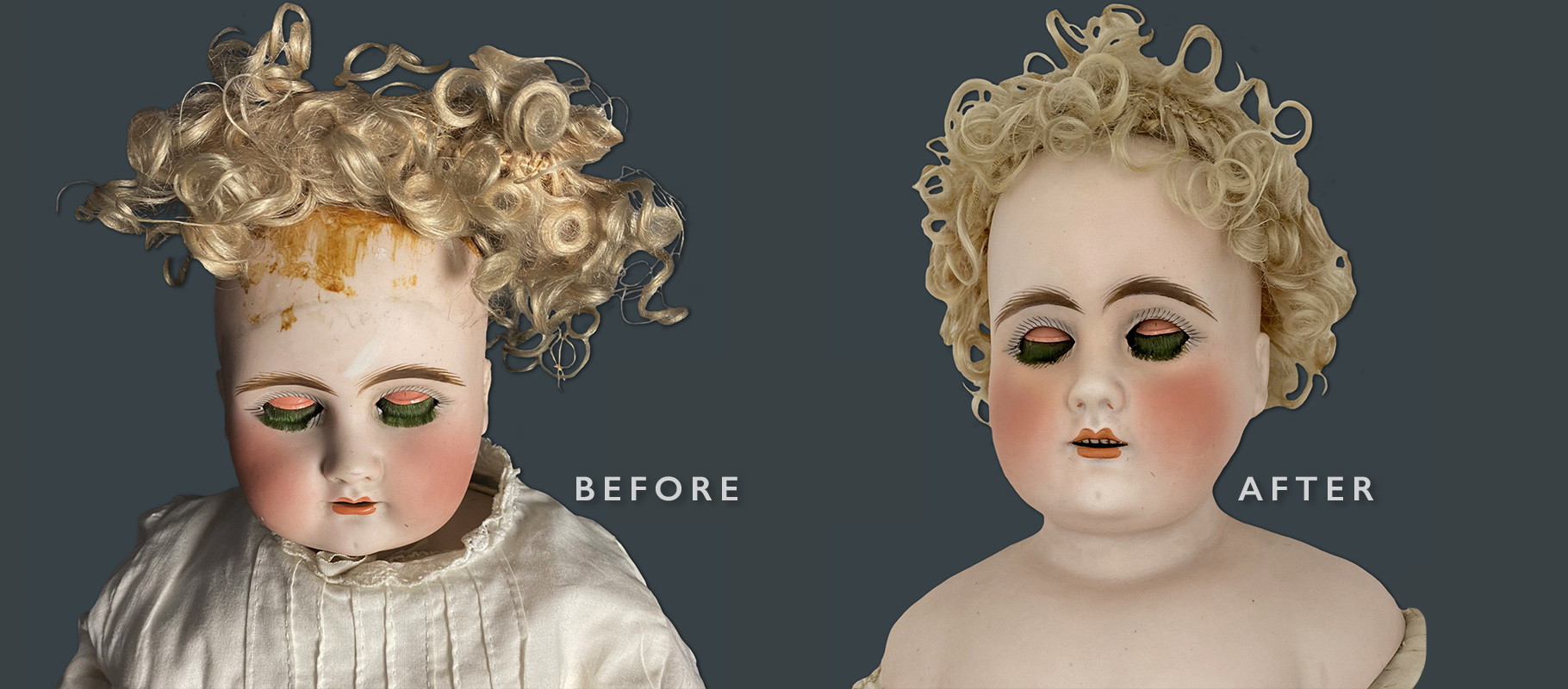
A recent project undertaken by our ceramics conservator involved the restoration of a porcelain doll. Historic glue used on the scalp had badly discoloured, leaving a severe visual disturbance. This was safely removed with a customised solution, along with a full surface clean and stabilisation of the body overall.
How can we help?
If you have any questions about doll restoration, please do not hesitate to get in touch. As part of our service we offer a nationwide collection and delivery service. E-mail us via [email protected] or call 0207 112 7576 for more information.

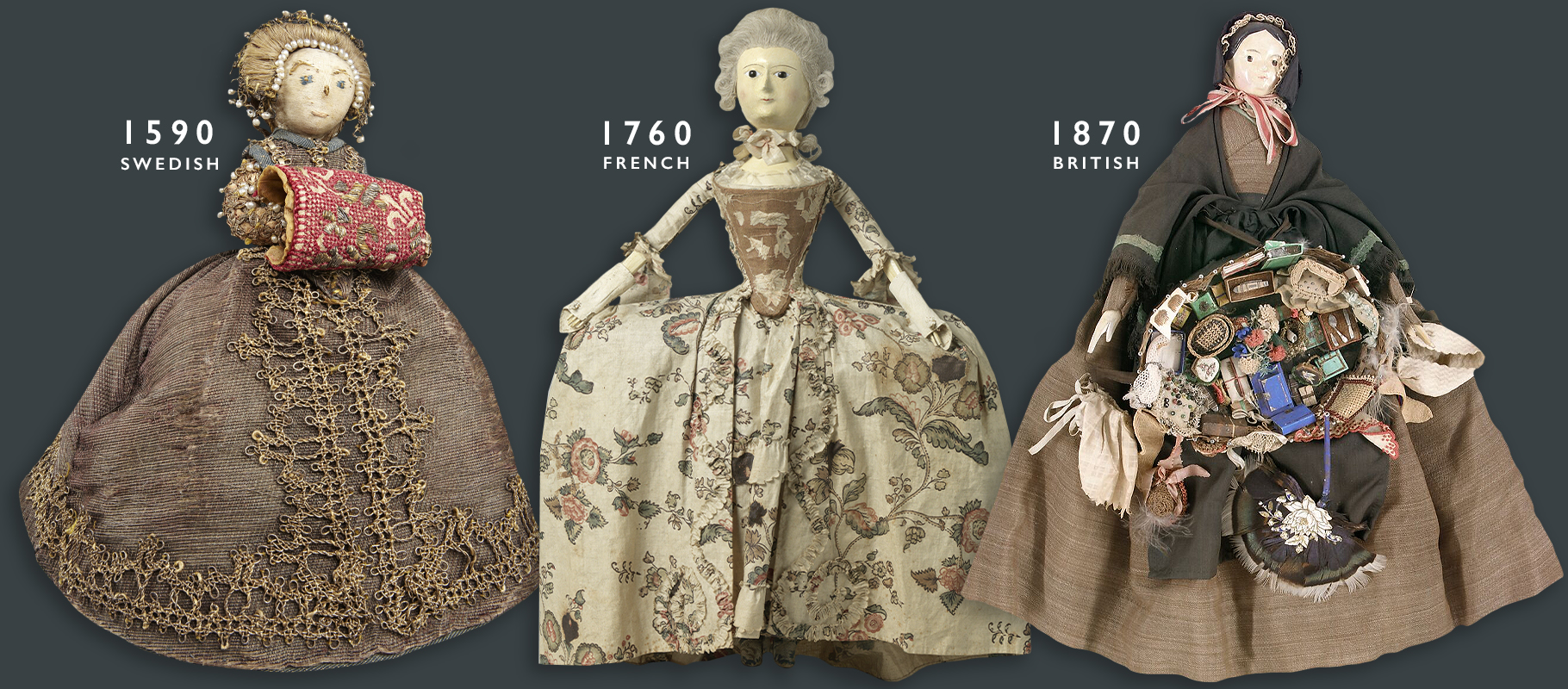 Above: three dolls from different eras including 16th century Sweden, 18th century France and 19th century Britain
Above: three dolls from different eras including 16th century Sweden, 18th century France and 19th century Britain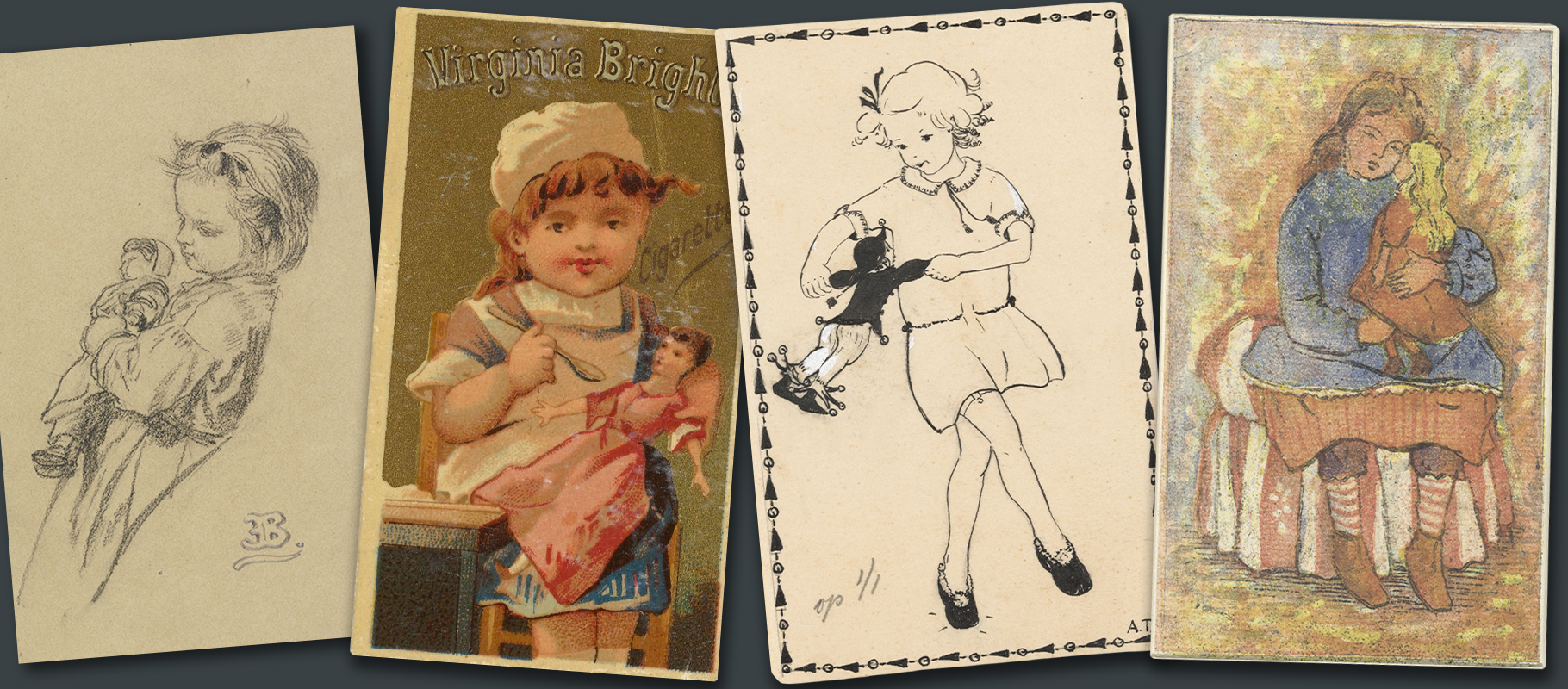 Above: a sketch by Eugène François de Block (1860), American cigarette card (1886), illustration by Tinbergen (1925-35) and a drawing by Lucien Pissarro (1873-1944)
Above: a sketch by Eugène François de Block (1860), American cigarette card (1886), illustration by Tinbergen (1925-35) and a drawing by Lucien Pissarro (1873-1944)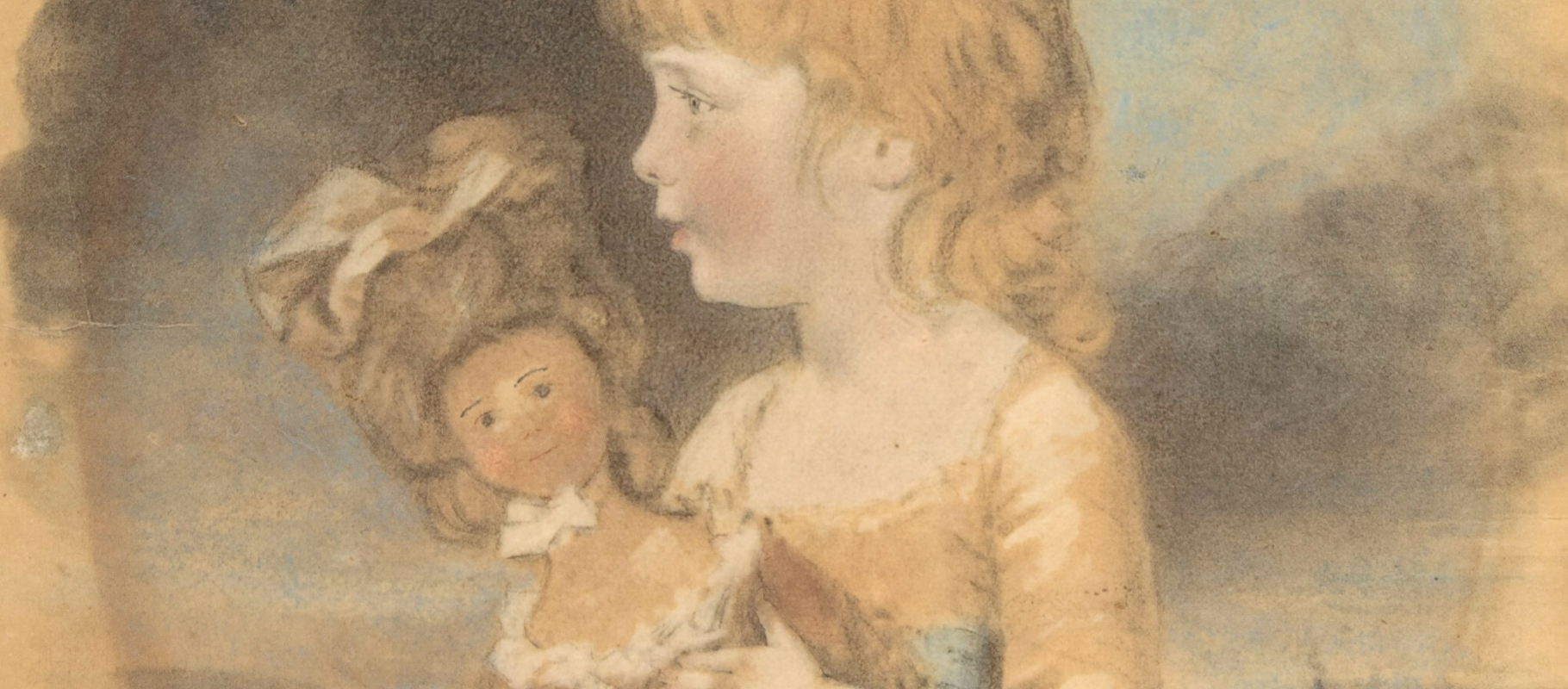 Above: detail from a graphite, watercolour and pastel drawing by John Downman, 1780
Above: detail from a graphite, watercolour and pastel drawing by John Downman, 1780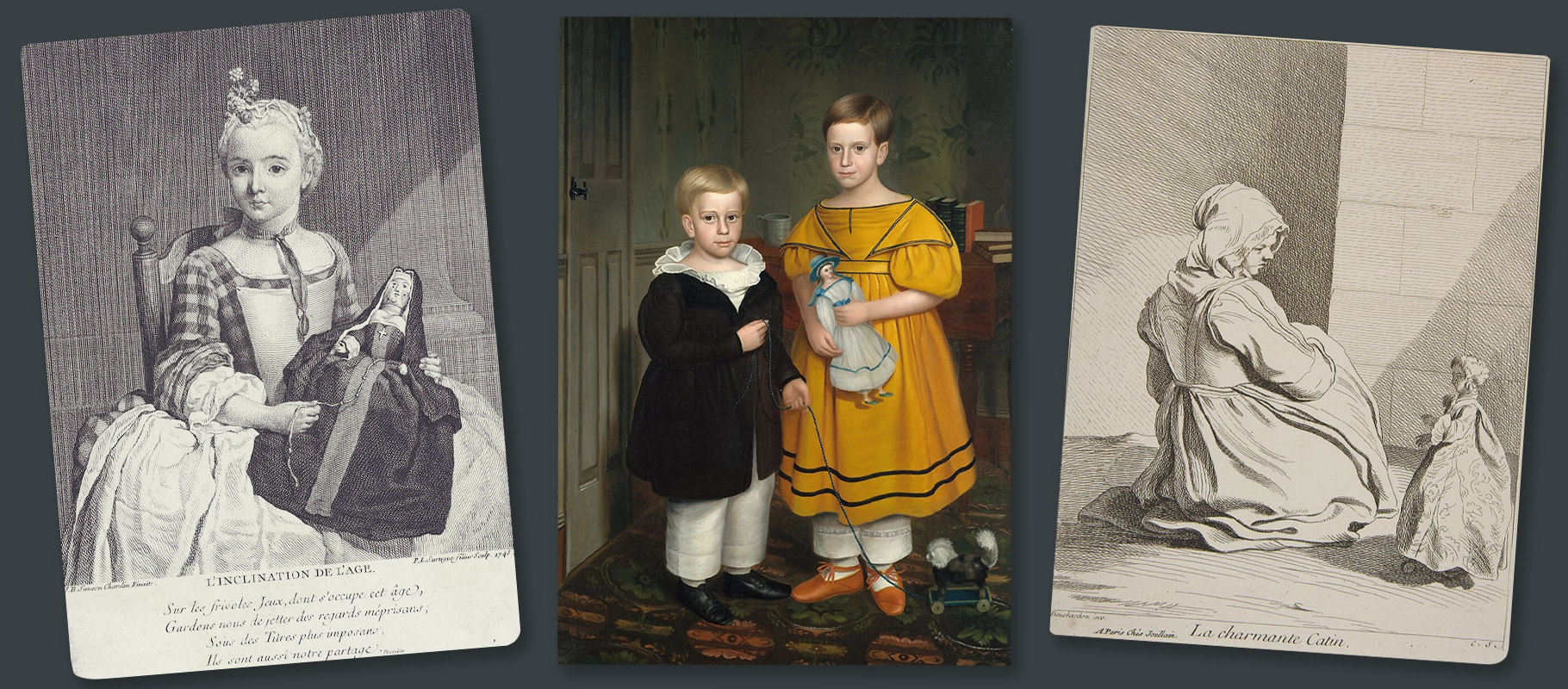 Above: an engraving entitled L’Inclination de l’age after Chardin (1743), oil portrait of The Raymond Children by Robert Peckham (1838) and an etching entitled The Charming Doll after Bouchardon (1742)
Above: an engraving entitled L’Inclination de l’age after Chardin (1743), oil portrait of The Raymond Children by Robert Peckham (1838) and an etching entitled The Charming Doll after Bouchardon (1742)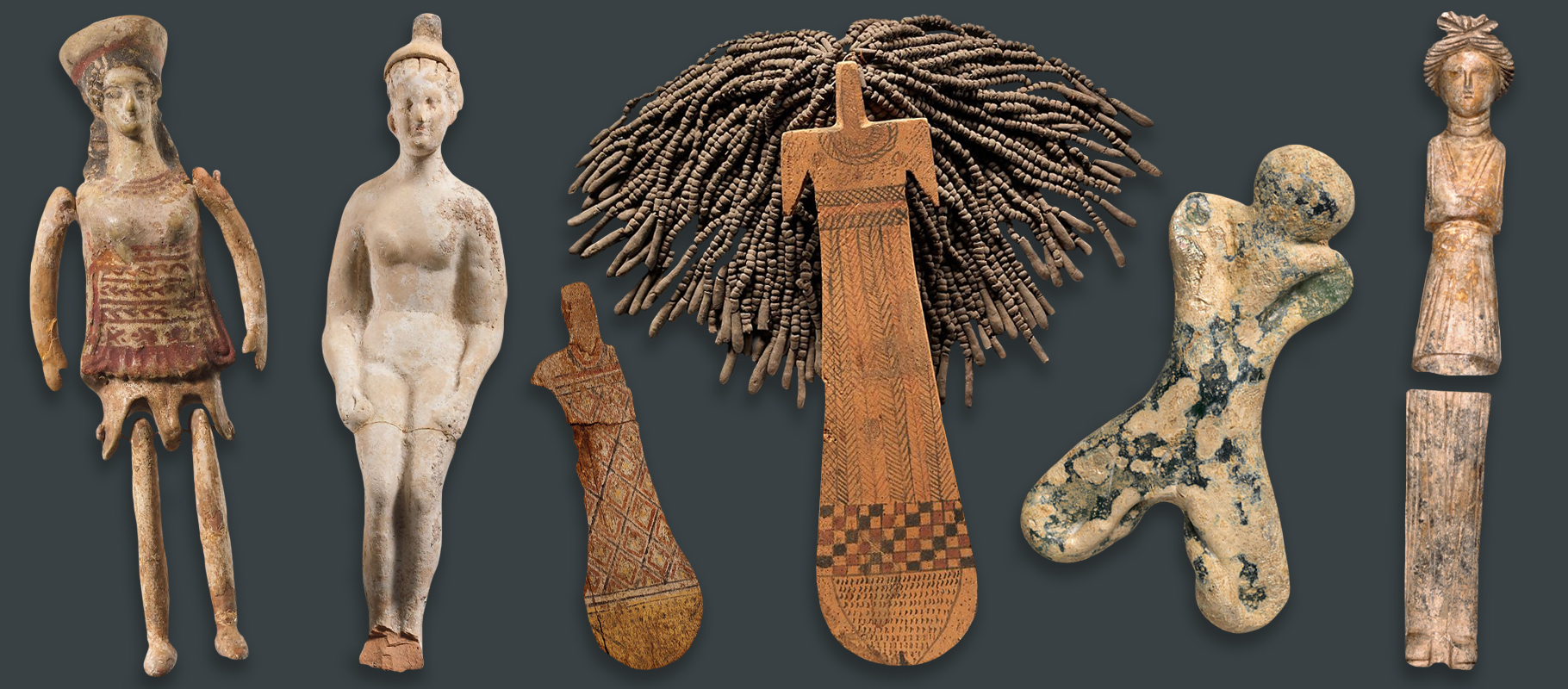 Above: terracotta dolls from ancient Greece, paddle dolls from ancient Egypt, a glass doll from ancient Iran and a bone doll from ancient Rome
Above: terracotta dolls from ancient Greece, paddle dolls from ancient Egypt, a glass doll from ancient Iran and a bone doll from ancient Rome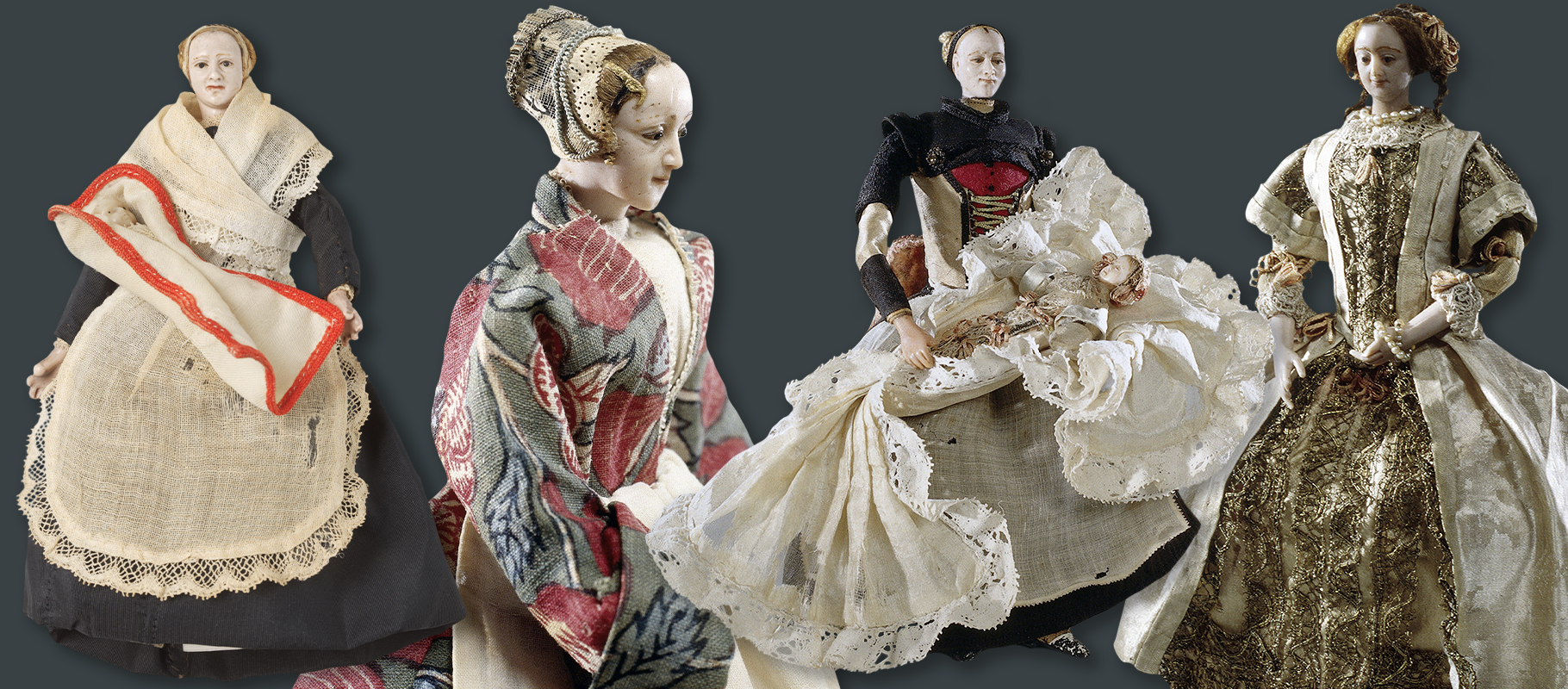 Above: figurines from a Dutch dolls house, 1676
Above: figurines from a Dutch dolls house, 1676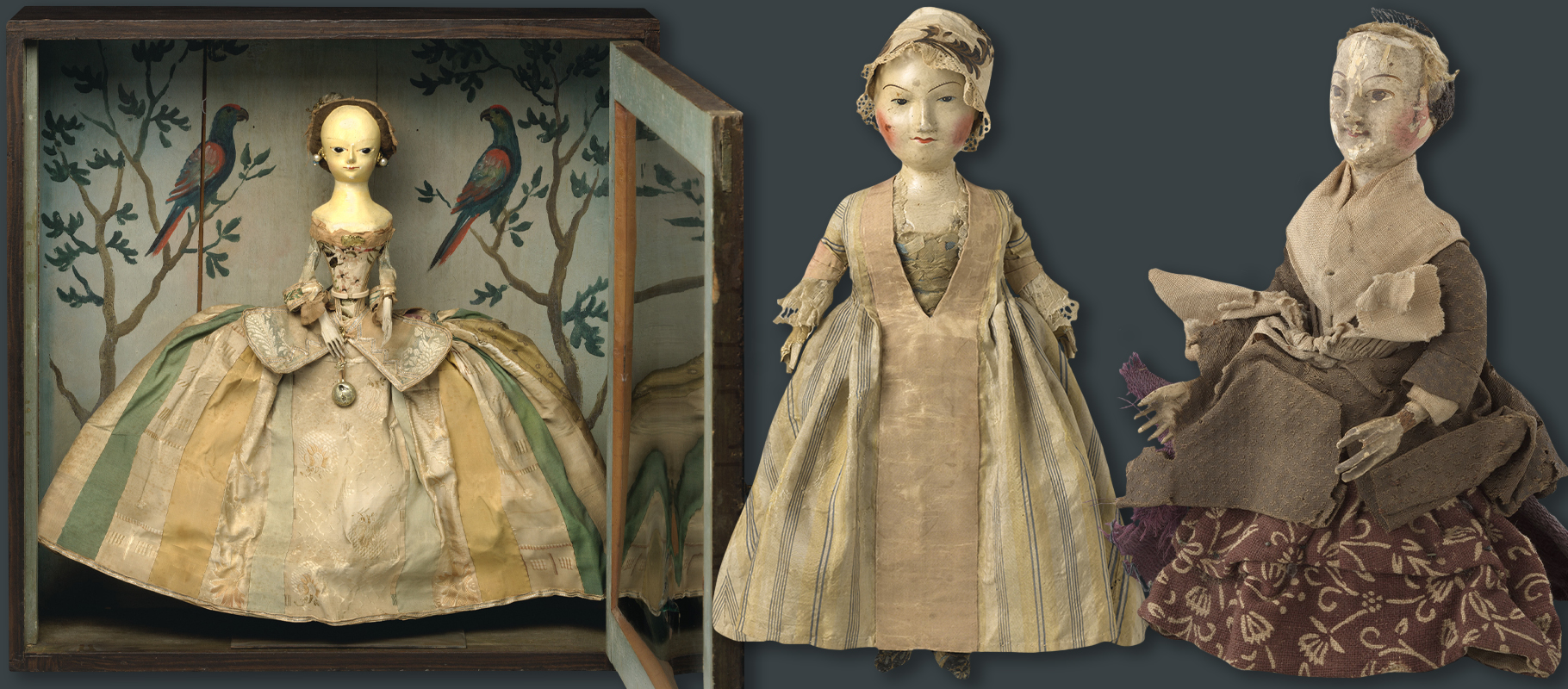 Above: three dolls from the 18th century
Above: three dolls from the 18th century 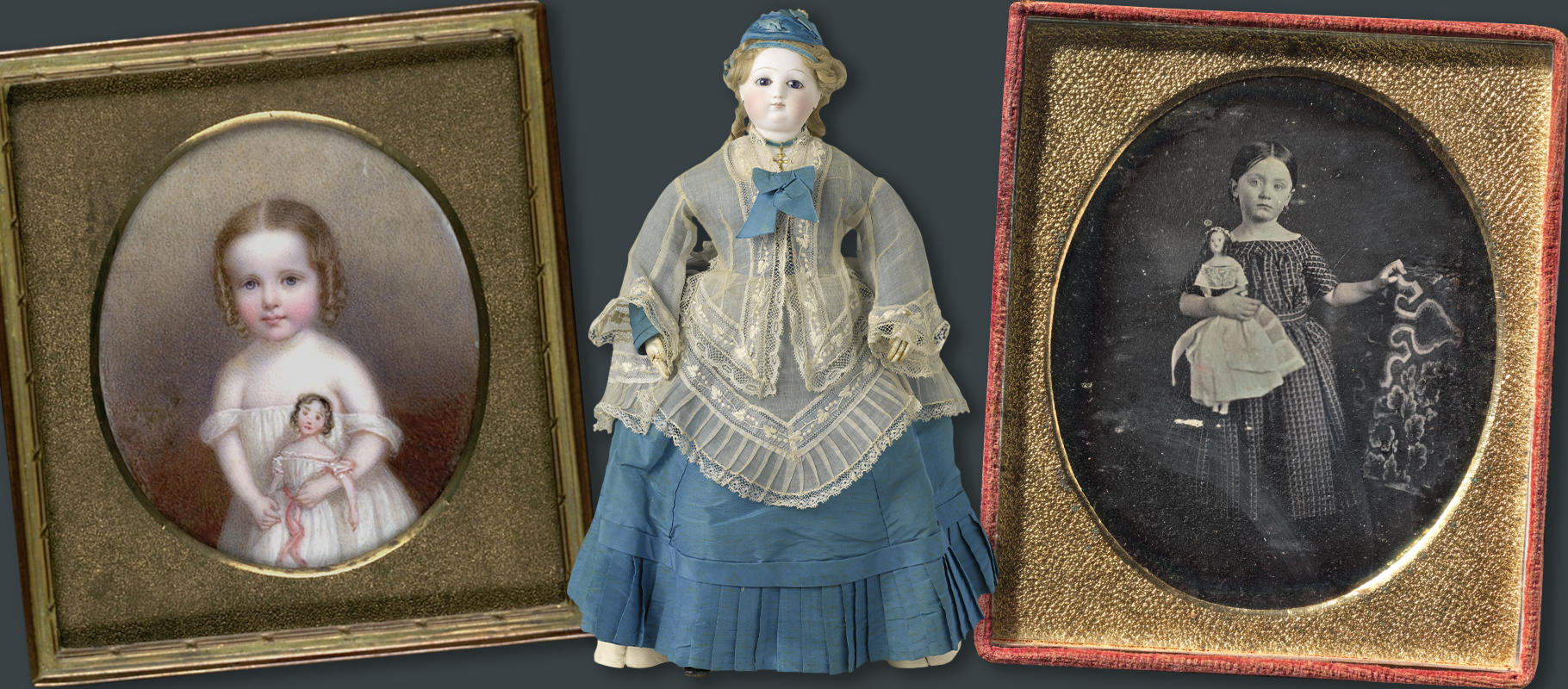 Above: a miniature of a girl and doll (1854), a doll with porcelain head and leather limbs (1874) and a Daguerreotype portrait of a girl and her doll (1850s)
Above: a miniature of a girl and doll (1854), a doll with porcelain head and leather limbs (1874) and a Daguerreotype portrait of a girl and her doll (1850s)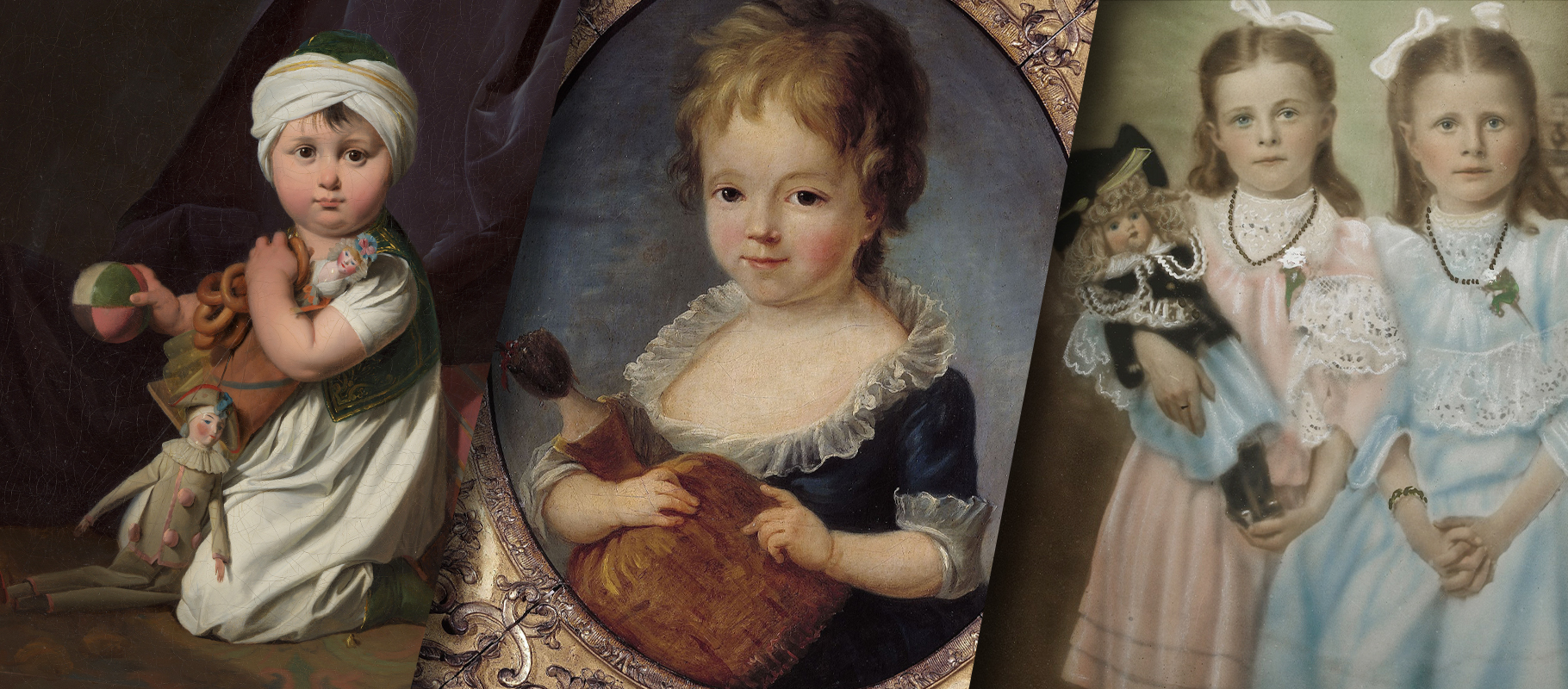 Above: details from an portrait of a boy by Louis Léopold Boilly (1805), portrait of a girl by François-Hubert Drouais (18th century) and a hand-coloured photographic print of two sisters (1915)
Above: details from an portrait of a boy by Louis Léopold Boilly (1805), portrait of a girl by François-Hubert Drouais (18th century) and a hand-coloured photographic print of two sisters (1915)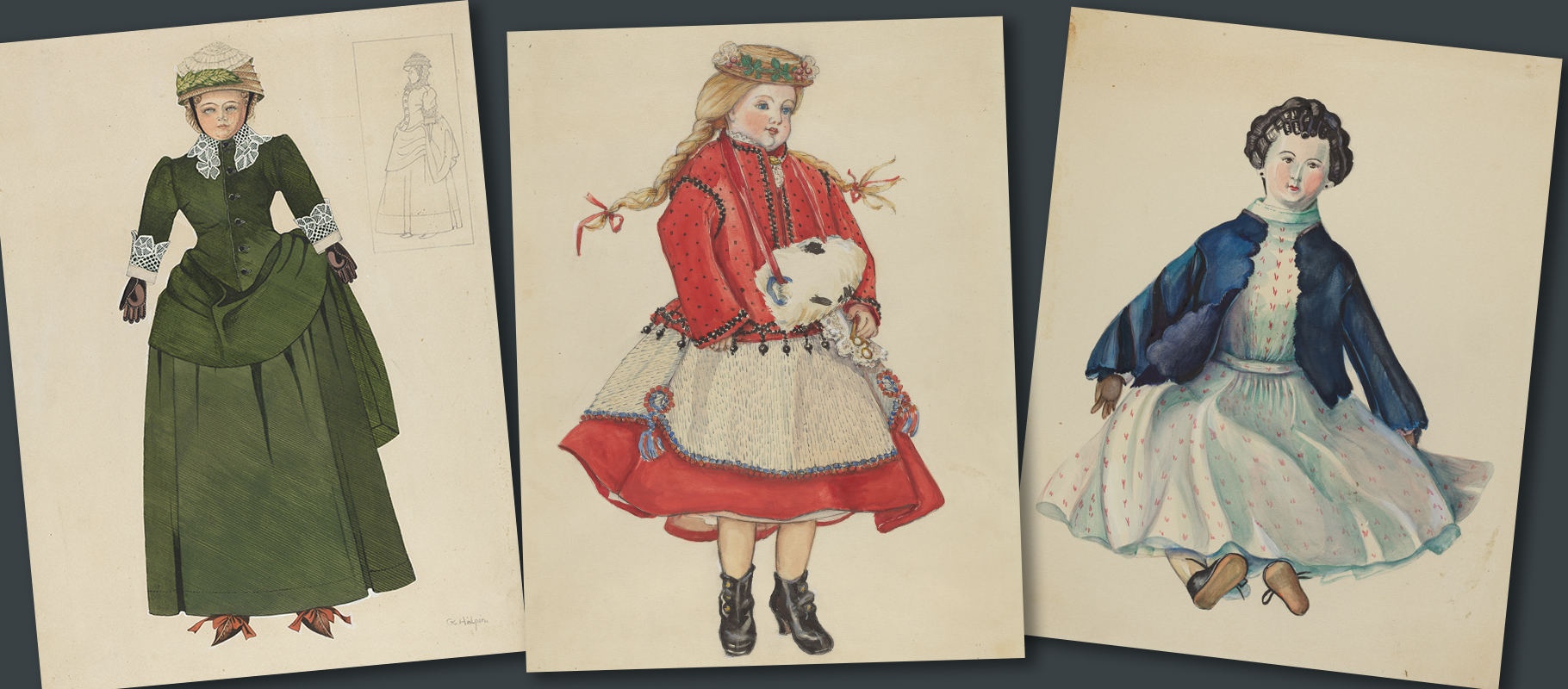 Above: drawings of different antique doll designs, 1930s
Above: drawings of different antique doll designs, 1930s Above: drawings of different antique doll designs, 1930s
Above: drawings of different antique doll designs, 1930s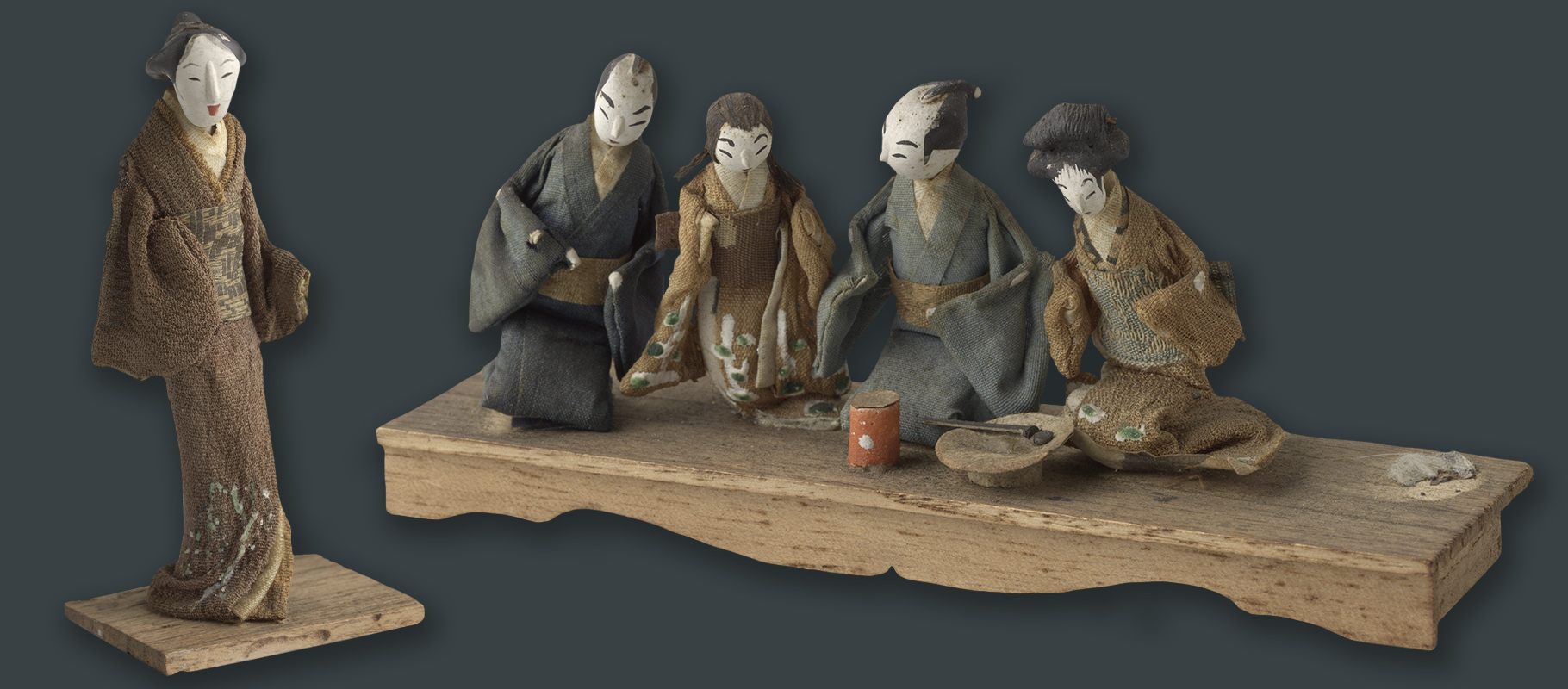 Above: a selection of Japanese dolls, early 20th century
Above: a selection of Japanese dolls, early 20th century Above: drawings of different antique doll designs, 1930s
Above: drawings of different antique doll designs, 1930s




